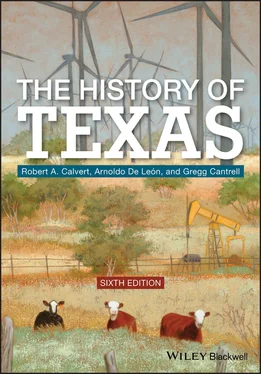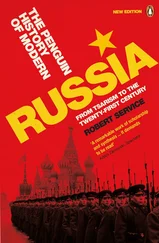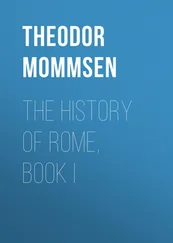A range of religious expression existed among the pobladores. Whereas some Tejanos displayed fidelity and piety, many others practiced a type of popular religiosity, as did other villagers living on the frontier, where the institutional church did not exert much influence. These nominal Catholics slighted the more restrictive tenets of their faith and violated certain of its scriptures, as evidenced by the government’s enactment of laws designed to curtail blasphemous behavior. In the town of Nacogdoches, for example, authorities arrested a citizen in 1805 for publicly criticizing the Church by placing “indecorous” posters on trees. Notwithstanding such irreverence, throughout the colonial era missionaries sought to minister to families, soldiers, and government representatives.
Presidios functioned as agents for defense by extending the velvet glove to hostile Indian tribes, such as the Apaches, or serving as trading centers and camps where friendly tribes might take refuge among their new Spanish allies. The frontier garrisons also assisted with missionization. Presidio troops tracked down runaway mission subjects, such as the Karankawas in La Bahía, and even undertook expeditions to replace runaways by kidnapping Indians to work in the missions’ households and fields. In such a role, the presidial staffs helped discipline the Indians and keep them in submission, thereby helping the missions maintain a sufficient labor force.
The presidio also served as the scene of much economic and social development. The presidial payroll influenced local economies. Moreover, the forts provided work for common laborers; purchased produce and finished goods from farmers, ranchers, and merchants; and hired the services of artisans. Furthermore, they helped entice people to the frontier by holding out prospects for steady employment and upward social mobility, especially for the poverty stricken or the lower castes. Many of the important Tejano families in the early nineteenth century were descendants of presidial servicemen. Those presidios built in territories far remote from civilian settlements attracted pioneers seeking refuge from an isolated or dangerous life. Sometimes extralegal (unofficial, or unauthorized) settlements sprang up near the more remote forts.
Ranchos and the cattle trade
On the frontier, civilians made their living off the land, with ranching becoming the principal livelihood of settlers in Texas. The amount of acreage the pobladores worked varied, for the size of a parcel given to an individual varied according to how the property owner planned to use it. For the keeping of large range animals and beasts of burden, the king granted one league of land, or 4428.4 acres. Those grantees intending to raise sheep, goats, or hogs received approximately 1920 acres. Cattle breeders received a unit of approximately 1084 acres. Normal procedure for land concessions called for the completion of an application and the payment of a fee. But in Texas, as in other regions of the Far North, more flexible standards prevailed, as well as a tradition of informal land granting. In Nacogdoches, for example, families acquired land simply by making a verbal agreement with a local official.
The assets of the frontier ranches stemmed from the first entradas (expeditions) into Texas. According to records, in 1689 Alonso de León brought to Texas 200 head of cattle, 400 horses, and 150 mules for the sole purpose of propagation. As he returned to Coahuila, he left a male and a female of each species on the bank of every stream he crossed in between the Neches River and the Rio Grande. In 1716, Domingo Ramón’s expedition imported 64 oxen, 500 horses and mules, and more than 1000 sheep and goats into Texas. Aguayo’s entourage had included nearly 4800 cattle, some 2800 horses, and about 6400 sheep and goats. José de Escandón and his colonizers marched toward the Rio Grande in 1748 driving herds of equine and bovine stock. Over the years, the animals that survived these entradas roamed throughout Texas, their numbers augmented over time through natural reproduction and unintentional release, such as during a stampede.
The first people to enter the ranching industry were the missionaries, those who had received the first land grants in Texas. But their stock soon multiplied beyond their control, with many individual animals straying off mission lands to join free‐ranging herds. The frontier people referred to all unclaimed wild stock as mesteños . And just as they had laid claim to the roving herds descendent from the animals imported through the early entradas, the settlers were quick to claim the missionaries’ livestock as soon as the animals had wandered into open pastures. As time passed, civilians who received land grants started their own ranches, often stocking their new enterprises with these “found” cattle.
The plains west of San Antonio to the Guadalupe River proved ideal for raising stock–one scholar refers to the area as the “cradle of Texas ranching”–and the mission ranches in this area enjoyed success. At La Bahía, the number of cattle increased from 3000 head in 1758 to 16,000 head by 1768. In the 1760s, the five San Antonio missions herded close to 5000 cattle, 1100 horses, and 10,000 sheep. Naturally, Béxareños residents of the San Antonio/Bexar area engaged in the livestock business to provide for numerous local needs, among them mounts for the military, sheep and goat products, and draft animals, including oxen. The settlers of Nacogdoches (a community surrounded by rich grasslands) after the 1780s also turned to ranching for their sustenance, and they earned a reputation throughout Louisiana and Texas for breeding fine horses. South of the Nueces River to the Rio Grande roamed another concentration of thousands of cattle, sheep, goats, mules, and horses. At the end of the eighteenth century, livestock raising flourished in Texas, the seeds of future, large‐scale cattle raising already sown.
The proliferation of the cattle ranches disguises the tremendous amount of energy that people exerted to wrest a living from a harsh environment. Generally, ranchers made their own corrals and other ranching necessities with the assistance of only their immediate families. They lived in homes better known for their function than their good looks. And because frontier people made their living working the land, they placed little emphasis on indoor living space. Typically, they built small houses with few modern amenities. Furnishings were homemade and often of an improvised design, among them furniture, bedding, and modest decorations. These conditions applied equally to the wealthier members of Tejano society, who also lived a fairly plain material existence. Although they had beef, poultry, and pork, most pobladores still cultivated a garden plot to supply their households with vegetables and fruits; usually, gardening fell to the women of the family.
Although most ranches amounted to no more than one‐family ventures, some had paid servants and slaves–in some cases, Indians served as virtual slaves. The notion that the colonial ranching elite was composed of romantic gentlemen of leisure is misleading. According to lore, these grandees refused to perform any work they considered demeaning, devoting themselves instead to gambling and the chase. In reality, the rancheros , as well as their wives and children, labored long, hard hours.
Nevertheless, the ranchos displayed the Spaniards’ ability to adapt to the topography of the new land. The ranchos were well suited to the semiarid plains, where farming was difficult. Furthermore, even with a shortage of labor the rancho might be very productive. Lastly, the rancheros could move their source of livelihood (their livestock) on short notice in order to save it from an impending raid or attack, a feat that a farmer with a field full of crops could not even contemplate.
Читать дальше










